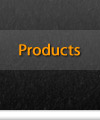|
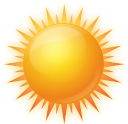 SUNSHINE
ACTION SUNSHINE
ACTION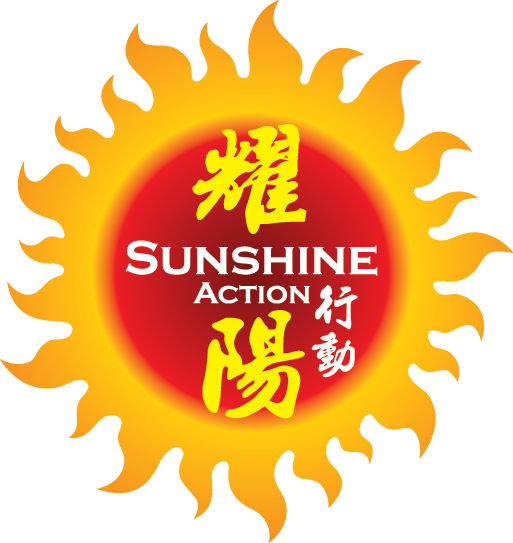 耀陽行動 耀陽行動
.png) SAVE the SEA SAVE the SEA 護生愛海洋 護生愛海洋

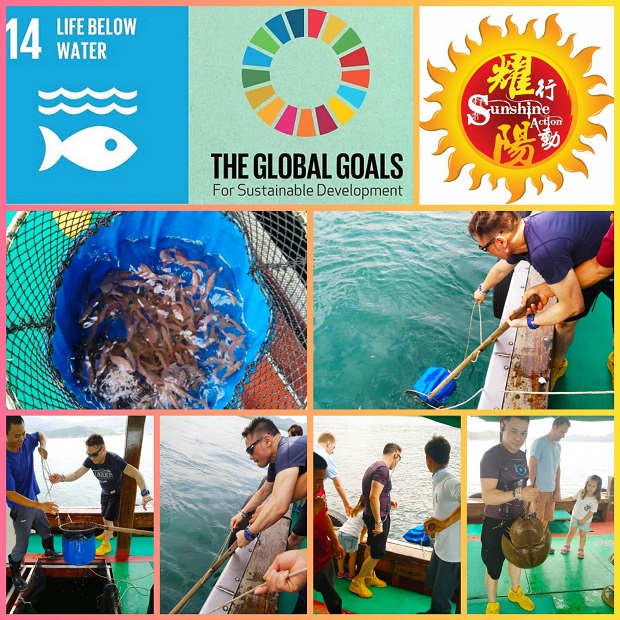
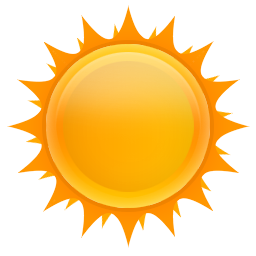 "Human have taken so much resources from the Ocean, "Human have taken so much resources from the Ocean,
our hope is to put back something in return..."
Released more than
129'800
indigenous fish & fry into the Ocean
Since 2010,
SUNSHINE ACTION
耀陽行動 started
'SAVE
the SEA
護生愛海洋'
Program which will promote the following
activities in the countries we visit:
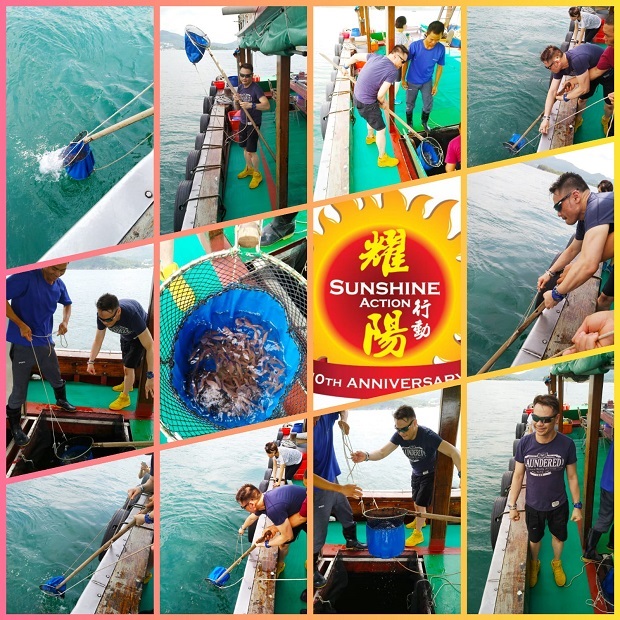
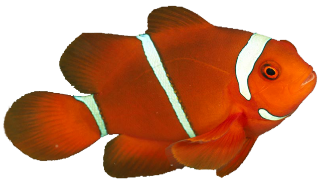 Restocking
the ocean '放生' in the sea by
releasing fish fry '魚苗'or
small fishes and other aquatic life appropriate to the ocean
region. Restocking
the ocean '放生' in the sea by
releasing fish fry '魚苗'or
small fishes and other aquatic life appropriate to the ocean
region.
 Promote appropriate sea environment for aquatic life living,
including mini Artificial Reefs to maximize the chance of
Survival for the fish & aquatic life. Promote appropriate sea environment for aquatic life living,
including mini Artificial Reefs to maximize the chance of
Survival for the fish & aquatic life.
 Promote responsible aquaculture. Promote responsible aquaculture.
 Promote cleaner beaches. Promote cleaner beaches.
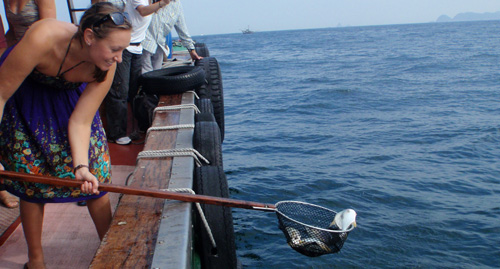
2018 - RESTOCKING THE OCEAN DATES:
- SAT 21 APR 2018 -
10:00 a.m.-12:00 noon
- SAT 19 MAY 2018 10:00 a.m.-12:00 noon
- SAT 2 MAY 2018 - 10:00 a.m. -12:00 noon
Please contact Sunny at:
852-6888
4028 sunshine@sunshine-action.org sunshine@sunshine-action.org
 SUNSHINE ACTION ltd
耀陽行動 SUNSHINE ACTION ltd
耀陽行動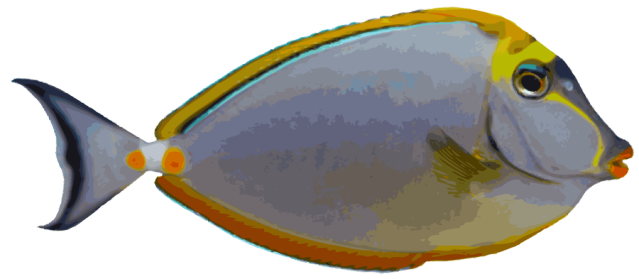 Sunshine Charity Beach Carnaval
Sunshine Charity Beach Carnaval
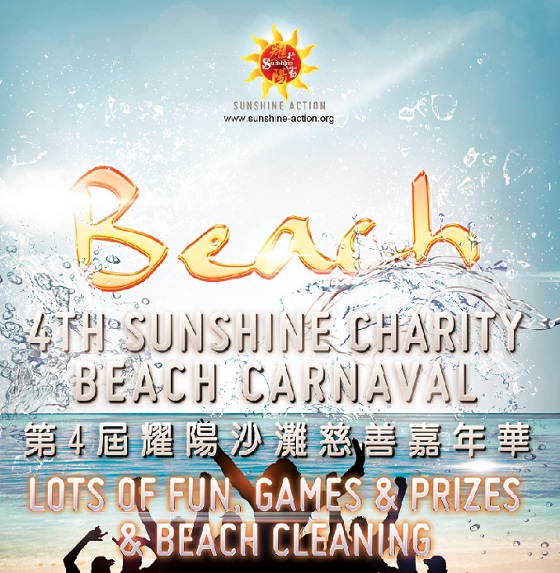

 www.sunshine-action.org/getinvolved/BeachCarnival.html www.sunshine-action.org/getinvolved/BeachCarnival.html
2008年12月5日第63屆聯合國大會通過第111號決議,決定自2009年起,每年的6月8日為“世界海洋日”。早在1992年,加拿大就已經在當年的里約熱內盧聯合國環境與發展會議上發出這一“World
Ocean Day 世界海洋日”提議,一年都有一些國家在這一天舉辦與保護海洋環境有關的非官方紀念活動。但直至2009年聯合國才首次正式確定的“世界海洋日”,聯合國希望世界各國都能藉此機會關注人類賴以生存的海洋,體味海洋自身所蘊含的豐富價值,同時也審視全球性污染和魚類資源過度消耗等問題給海洋環境和海洋生物帶來的不利影響,而2014年我們的“世界海洋日”的主題被確定為

 我們的海洋,我們的寶藏
Our Ocean, Our
Treasure 我們的海洋,我們的寶藏
Our Ocean, Our
Treasure
Some of the species released by
SUNSHINE ACTION
耀陽行動 in the Ocean:
Released more than
118'880
indigenous fish & fry into the Ocean
-
將超過118'880
條經常遭濫捕的魚苗放回大海.
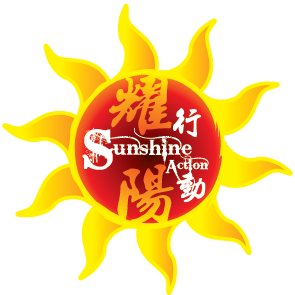
-
Serranus merra
金錢斑
:
金錢斑的主要產地在紅海、非洲東岸,澳洲與台灣也有少量生產,體灰褐色,有暗斑約排成五個總列點,屬於大型石斑,中文學名為藍身大石斑,已被澳洲列入保護魚種.
–
Seriola dumerili (Seriola purpurescens)
章雄
-
Lutianus argentimaculatus
紅鮪
- Tachypleus tridentatus
中國鱟:
is the only horseshoe crab species in Japan and is protected as
a national treasure, but a sharp decline in number has been
reported in recent years as a consequence of habitat destruction
and marine pollution. The Blue Blood of this animal is famous
for very high medical value.
-
Yellow Tail
油甘魚 :
On the
most consumed raw fishes in SUSHI Restaurants around the World.
-
Lutjanus Sabae 紅魚
-
Areolate Grouper
芝麻斑
- Star Snapper
石蚌
-Siganus
Oramin (Rabbit Fish)
泥鯭
- Marbled rockfish
石九公:
石九公是華南一帶的稱呼,酷似石斑魚,但體型細小,只有2O厘米長,有多個種類。 頭上有刺,第一背鰭大而且硬,是石九公的特徵。 魚身的顏色隨環境而變異,如棲息在淺水岩礁的,牠便呈紅色,生息在深水岩礁間的,牠便呈赤紅色,並有深黃色的斑紋。
-
Trachinotus blochii
黃立倉
-
Acanthopagrus schlegeli
黑立
☀SUNSHINE ACTION 耀陽行動
purpose on this is not about ‘saving their lifes’ as main
purpose for the Buddhist… but we want to re-stock the ocean with
fish. So we observe the following consideration to maximize
their survival chances:
只放本土魚苗種 We release only native
species appropriate to local sea waters. For example, we won’t
buy a lobster from BOSTON and then put in Hong Kong water.
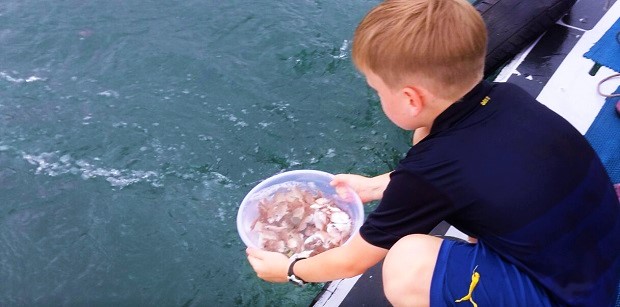
不要放開淡水魚入海 Of course we won’t
release fresh water species into the sea.
溫暖的天氣放生 We choose mostly the warmer
seasons to do this practice, so the water temperature won’t be
too cold.
在保護區放生 We release in protected
areas which is constantly supervised by HK police against the
Fishing Boats and near the area where HKG government sank 18
boats to create the artificial reef right outside of Sai Kung.
一般不放生大魚 We don’t release big fishes
generally – Buddhist would release BIG fishes as they consider
more intelligent in its spirit- We prefer fry that is
appropriate to the hatchery season of the species.
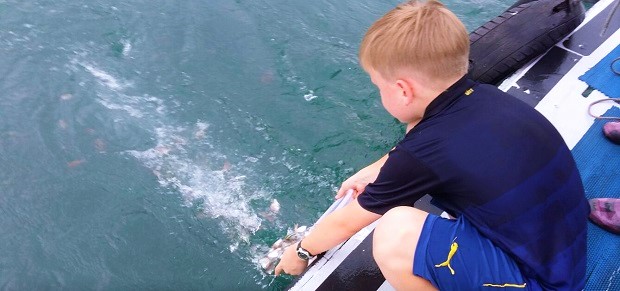
低調放生 In general, we make it very
low-profile during the event, basically NOBODY would notice from
outside the boat any sign of the activity.
接近捕"休魚期"放生 This is also closer to
the period when CHINA have about 2 months fishing rest period in
the year, mostly during Summer.
Please teach next generation to treasure ocean resources
教下一代珍惜海洋資源 以其生生不息
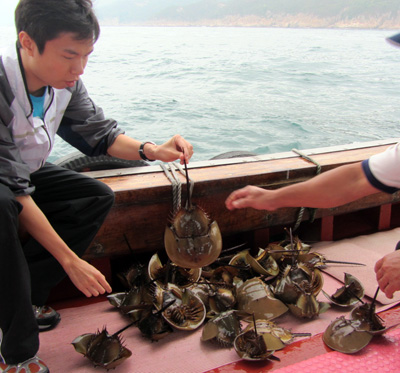
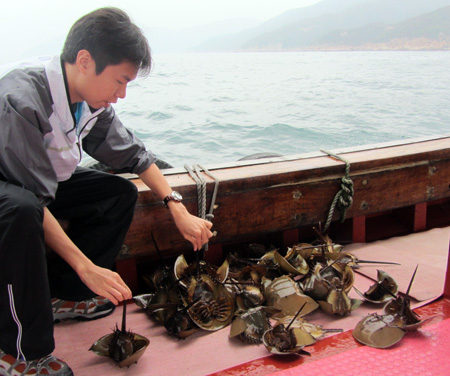

852-6888
4028 sunshine@sunshine-action.org sunshine@sunshine-action.org
|
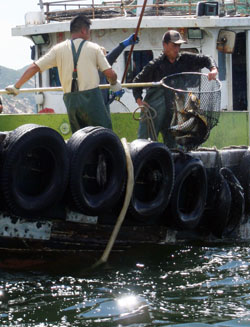
|
 Overfishing occurs when fishing
activities reduce fish stocks below an acceptable level. Overfishing occurs when fishing
activities reduce fish stocks below an acceptable level.
We often consume too many marine resources, but forget to put
back in return. The fishing rest period in Hong Kong is only 2
months which is far from enough. In China, this period is
2.5 months only.
Ultimately overfishing may lead to resource depletion in
cases of subsidised fishing, low biological growth rates and
critical low biomass levels. For example, overfishing of sharks has led to the
upset of entire marine ecosystems.
|
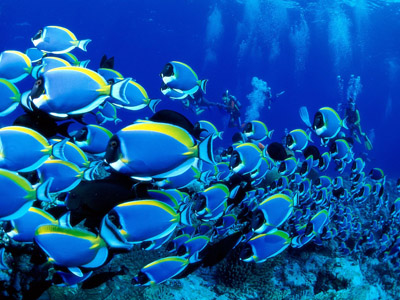 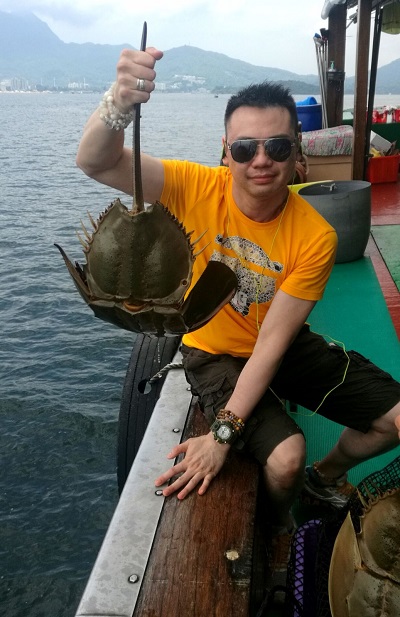
**Donation over HKD 100 is tax-deductible in Hong Kong under IRD-No. 91/10271***
捐款HK$100元或以上,可獲香港退稅收據.
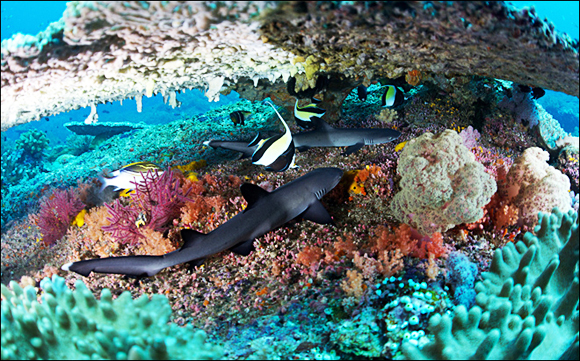
|
The ability of fisheries to naturally recover also depends on
whether the conditions of the ecosystems are suitable for
population growth. Dramatic changes in species composition may
establish other equilibrium energy flows that involve other
species compositions than had been present before (ecosystem
shift). For example, remove nearly all the trout, and the carp
might take over and make it nearly impossible for the trout to
re-establish a breeding population.
|
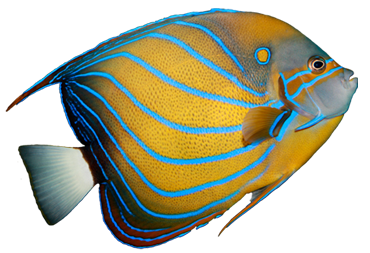
|
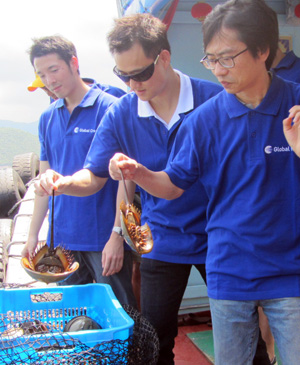
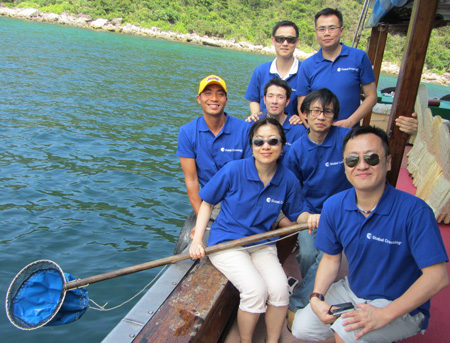

|
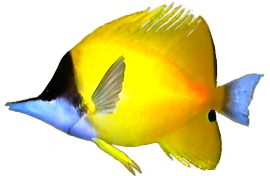
|
According to a 2008 UN report, the world's fishing fleets are
losing $50 billion USD each year through depleted stocks and
poor fisheries management.
The report, produced jointly by the
World Bank and the UN Food and Agriculture Organization (FAO),
asserts that half the world's fishing fleet could be scrapped
with no change in catch. In addition, the biomass of global fish
stocks have been allowed to run down to the point where it is no
longer possible to catch the amount of fish that could be
caught.
|
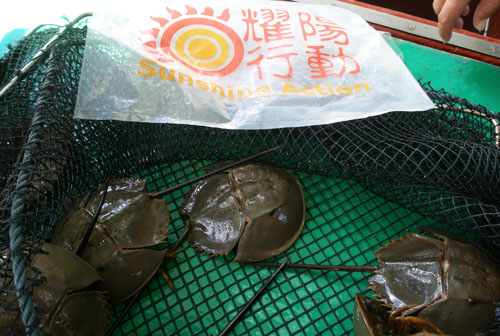 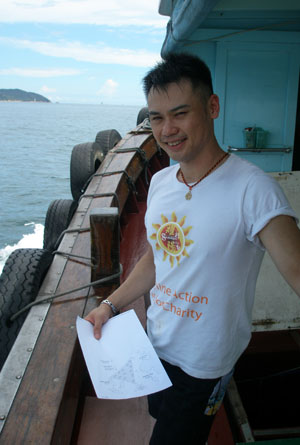
With present and forecast levels of the world population it
is not possible to solve the overfishing issue; however, there
are mitigation measures that can save selected fisheries and
forestall the collapse of others.
852-6888
4028 sunshine@sunshine-action.org sunshine@sunshine-action.org
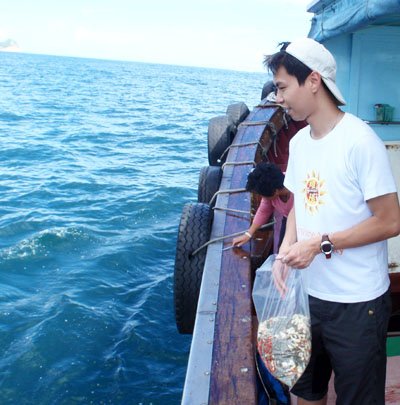 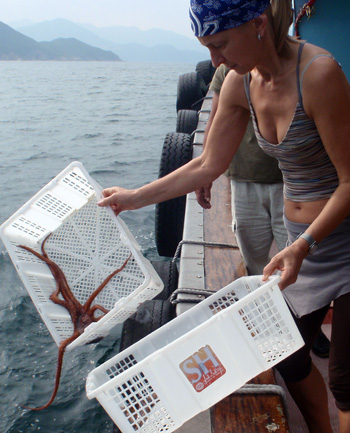
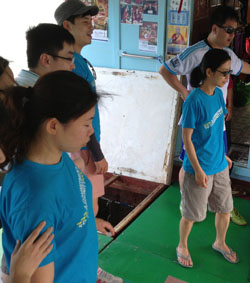

|
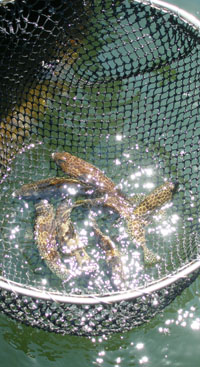
|
 The "United Nations Convention on the Law of the Sea"
treaty deals with aspects of overfishing in
articles 61, 62, and 65. The "United Nations Convention on the Law of the Sea"
treaty deals with aspects of overfishing in
articles 61, 62, and 65.
-
Article 62 provides that coastal states: "shall
promote the objective of optimum utilization of the
living resources in the exclusive economic zone
without prejudice to Article 61"
-
Article 65 provides generally for the rights of,
inter alia, coastal states to prohibit, limit, or
regulate the exploitation of marine mammals.

|
Another possible solution, at least for some areas, is
fishing quotas, so fishermen can only legally take a certain
amount of fish. A more radical possibility is declaring certain
areas of the sea "no-go zones" and make fishing there strictly
illegal, so the fish in that area have time to recover and
repopulate.
|
Controlling consumer behavior and demand is a key in
mitigating action. Worldwide a number of initiatives emerged to
provide consumers with information regarding the conservation
status of the seafood available to them. The Guide to Good Fish
Guides lists a number of these.
|
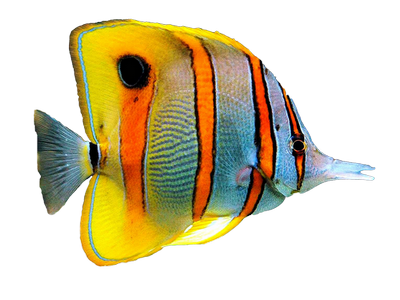
|
According to BLOOMBERG
Philanthropies:
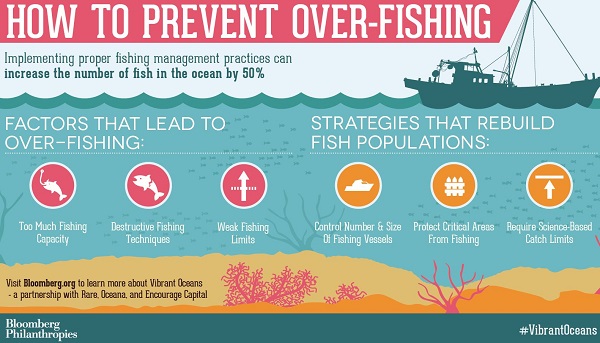
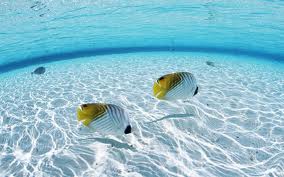 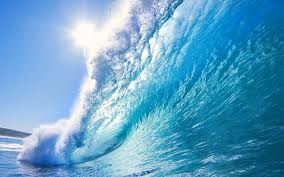

|
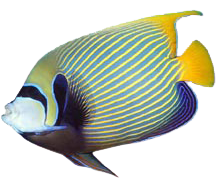
|
HONG KONG 香港
Sunshine Action is planning to
release over 20'000 fish fry appropriate to the
Hong Kong sea in
2017:
|
|
Give life
放生
Date in HK :
***Sai Kun Public Ferry
Pier***
2017
 SUNDAY 01 JAN SUNDAY 01 JAN
 MON
1 MAY
- 12:00 noon - 2:00 p.m. MON
1 MAY
- 12:00 noon - 2:00 p.m.
 SUN
02
Jul SUN
02
Jul
 4:00-5:30 p.m.
4:00-5:30 p.m.
|
 HK$880
/volunteer to join the event HK$880
/volunteer to join the event
|
852-6888
4028 sunshine@sunshine-action.org sunshine@sunshine-action.org
|
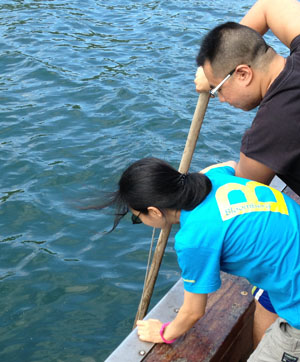
|
 香港位於中國東南海岸,由九龍半島和200多個小島組成,雖然本港水域面積 (1650平方公里) 僅為南中國海 (340萬平方公里)
的0.05%,但海魚的種類卻佔南中國海水域的三成。香港海魚種類繁多,原因是水文獨特,而且有各種不同的生境。香港水域匯合了三種沿岸流(中國海沿岸流、南中國海流和黑潮)、珠江徑流和湧升流,此外,亦有各式各樣的海洋生境,包括泥質和沙質的底土層、岩岸、珊瑚礁和新敷設的人工魚礁等。 香港位於中國東南海岸,由九龍半島和200多個小島組成,雖然本港水域面積 (1650平方公里) 僅為南中國海 (340萬平方公里)
的0.05%,但海魚的種類卻佔南中國海水域的三成。香港海魚種類繁多,原因是水文獨特,而且有各種不同的生境。香港水域匯合了三種沿岸流(中國海沿岸流、南中國海流和黑潮)、珠江徑流和湧升流,此外,亦有各式各樣的海洋生境,包括泥質和沙質的底土層、岩岸、珊瑚礁和新敷設的人工魚礁等。
香港魚類學的研究有150年歷史,錄得的海水魚達997種,分屬27目135科,約佔南中國海海魚種類(3365種)的三成。據文獻所載,台灣和菲律賓;香港東北和東南水域的海魚超過2000種。預計將來香港水域會錄得更多的魚類品種。
|
本港最常見的十科魚類包括虎魚科(74種)、隆頭魚科(41種)、鮨科(39種)、笛鯛科(35種)、雀鯛科(30種)、天竺鯛科(27種)、石首魚科(24種)和蝴蝶魚科(23種)。
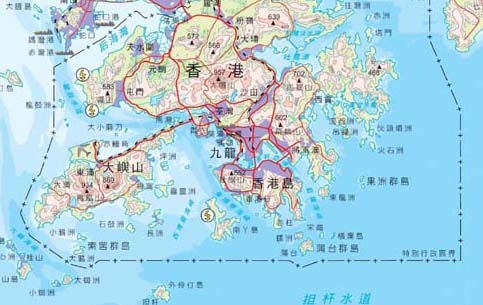
Hong Kong, comprised of a
single peninsula and over 200 offshore islands, is situated in
the southeastern coast of Mainland China. Though the territorial
waters of Hong Kong (1650 km²) is only 0.05% that of the South
China Sea (3.4 million km²), the marine fish diversity of the
former is about 30% that of the latter. This relatively high
fish diversity is the result of Hong Kong's unique hydrology and
diverse habitat. Hong Kong waters is a mixture of 3 coastal
currents (the Chinese Coastal Current, the South China Sea Drift
and Kuroshio Current ), Pearl River runoff and upwelling. In
addition, there are diversified marine habitats including muddy
and sandy substratum, rocky shores, coral reefs and the recently
deployed artificial reefs.
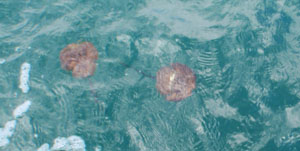
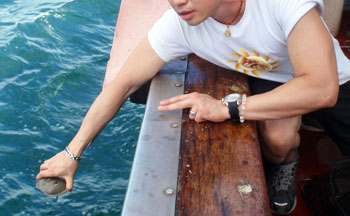
 Throughout one and a half
centuries of Hong Kong ichthyological history, a total of 997
marine fish species of 135 families and 27orders were recorded.
This is about 30% of the total fish species (3365 species) that
can be found in the South China Sea. Within the waters of Taiwan
and the Philippines, northeastern and southeastern of Hong Kong,
over 2000 marine fish species were documented. It is expected
that more and more fish species will be recorded in Hong Kong
waters in the coming future. Throughout one and a half
centuries of Hong Kong ichthyological history, a total of 997
marine fish species of 135 families and 27orders were recorded.
This is about 30% of the total fish species (3365 species) that
can be found in the South China Sea. Within the waters of Taiwan
and the Philippines, northeastern and southeastern of Hong Kong,
over 2000 marine fish species were documented. It is expected
that more and more fish species will be recorded in Hong Kong
waters in the coming future.
|
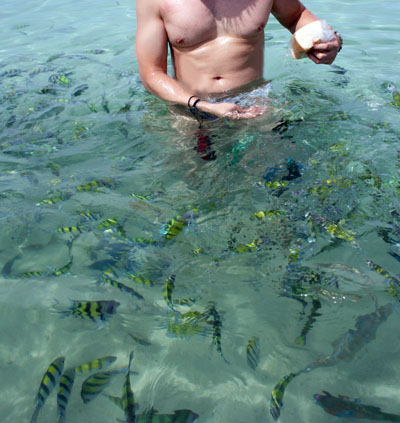
|
 The 10 most abundant fish
families are Gobiidae (74 species), Labridae (41 species),
Serranidae (39 species), Carangidae (39 species), Lutjanidae (35
species), Scorpaenidae (33 species), Pomacentridae (30 species),
Apogonidae (27 species), Sciaenidae (24 species) and
Chaetodontidae (23 species). The 10 most abundant fish
families are Gobiidae (74 species), Labridae (41 species),
Serranidae (39 species), Carangidae (39 species), Lutjanidae (35
species), Scorpaenidae (33 species), Pomacentridae (30 species),
Apogonidae (27 species), Sciaenidae (24 species) and
Chaetodontidae (23 species).
|
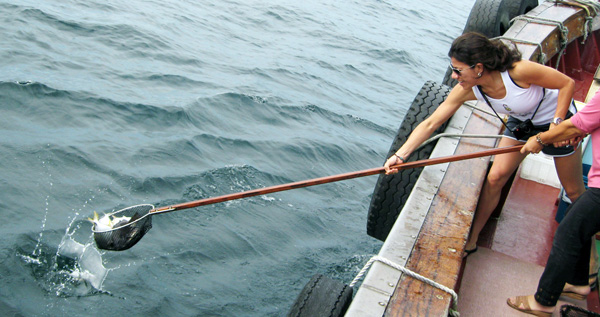
 Artificial Reef
人工魚礁 Artificial Reef
人工魚礁
人工魚礁是非常有效的聚集及支援大量魚群的裝置,它能為香港大多數只有軟底的海床的水域提供一些複雜的硬面生態環境。大型的人工魚礁更可藉改變水流為魚類提供理想的覓食機會。當水流過大型的人工魚礁時,外圍會形成高流量區,而下游地帶即形成低流量區。這些水流區能聚集水中的浮游生物,吸引攝食它們的魚類和這些魚類的捕食者。人工魚礁亦可促進附著生物的定居和發展,這些附著生物如多毛蟲,藤壺和貽貝等在人工魚礁成長,因此吸引更多獵食者如蟹、蝦和魚類等前來覓食,為生態環境有限的海域創造了出一個全新和複雜的食物網.
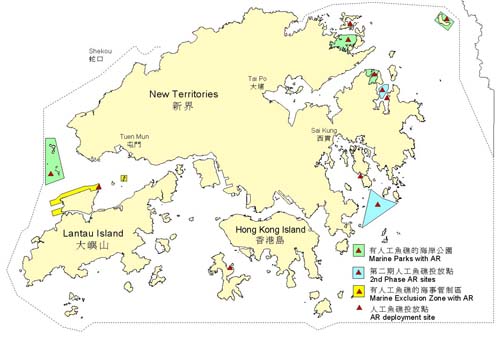
|
Artificial reefs are very effective devices for attracting and
supporting large populations of fish. They can provide complex,
hard surface habitat in areas where only soft bottoms occur,
which includes much of Hong Kong waters. Large artificial reef
structures also provide improved feeding opportunities for many
fish by changing water flow patterns.
|
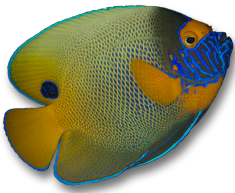
|
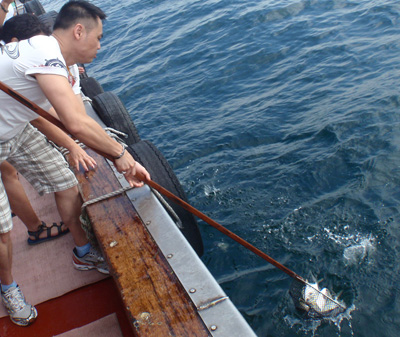 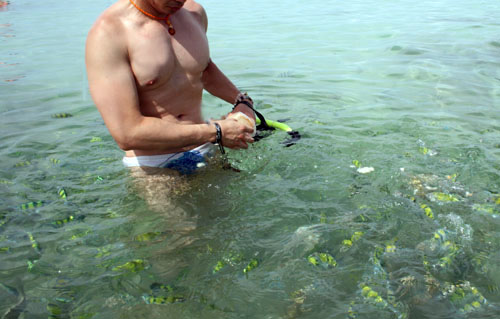
 These areas of high flow are created as moving water passes over
and around large artificial reef structures and low flows are
established in sheltered areas inside the structure and at the
downstream side. High current flows attract plankton feeding
fish and their predators. Artificial reefs also provide good
opportunities for planktonic fouling organisms to settle and
develop. These fouling organisms, which include polychaetes,
barnacles and mussels, flourish on artificial reefs and attract
many predators, such as crabs, shrimps and fish, to feed and be
fed. Artificial reefs create new and complex food webs in areas
that are habitat-limiting. These areas of high flow are created as moving water passes over
and around large artificial reef structures and low flows are
established in sheltered areas inside the structure and at the
downstream side. High current flows attract plankton feeding
fish and their predators. Artificial reefs also provide good
opportunities for planktonic fouling organisms to settle and
develop. These fouling organisms, which include polychaetes,
barnacles and mussels, flourish on artificial reefs and attract
many predators, such as crabs, shrimps and fish, to feed and be
fed. Artificial reefs create new and complex food webs in areas
that are habitat-limiting.
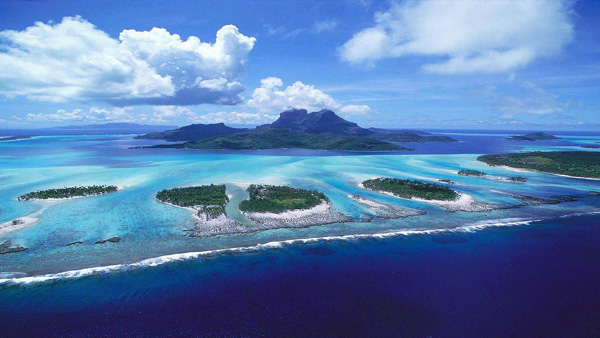
852-6888
4028 sunshine@sunshine-action.org sunshine@sunshine-action.org
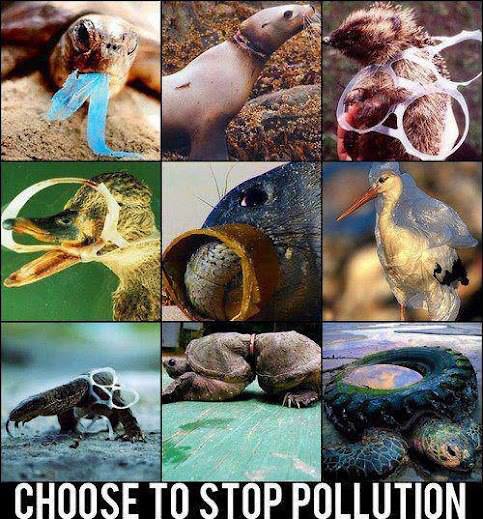
This is Peanut the turtle, shortly
after being found in Missouri in 1993. She was taken to to a zoo
in St. Louis where the six-pack ring was removed.
It seems that she was trapped in the plastic ring as a young
turtle and was unable to free herself. Subsequently her shell
moulded itself to the plastic ring and she grew in the strange
shape you see here.
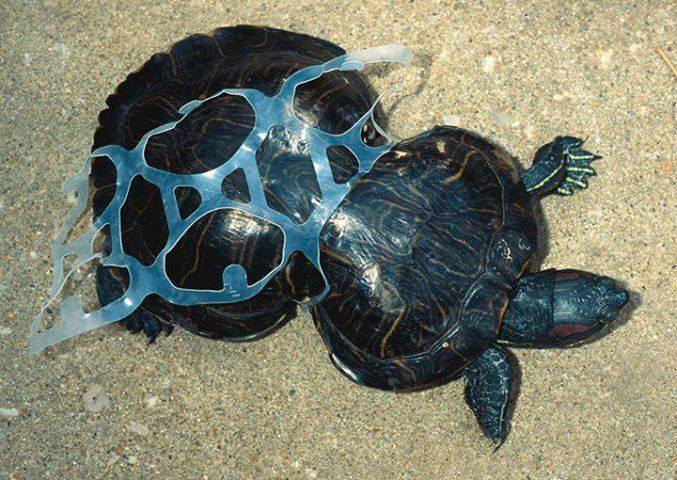
Unfortunately the damage is permanent,
but peanut is expected to live a long life and today she serves
as a mascot for the fight against beach littering.
Please, always remember to clean up after yourself at the beach

**Donation over HKD 100 is tax-deductible in Hong Kong under IRD-No. 91/10271***
捐款HK$100元或以上,可獲香港退稅收據.
852-6888
4028 sunshine@sunshine-action.org sunshine@sunshine-action.org
Sunshine Action Ltd is only based in Hong
Kong & This is the only official Website. |





